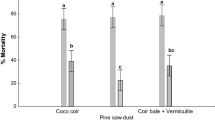Abstract
The potential of entomopathogenic nematodes as biologicalcontrol agents for carrot weevil (Listronotus oregonensis) was evaluated throughboth laboratory and field experiments. In thelaboratory, Steinernema carpocapsae, S. riobrave, S. feltiae, Heterorhabditis megidis, H. bacteriophora, and a control (water only) werecompared in sand and muck soil against adults,and in sand against larvae. All nematodespecies produced high levels of larvalmortality. S. carpocapsae producedsignificantly greater adult mortality in sandthan other species or the untreated control. H. bacteriophora caused low adultmortality in sand, but the greatest adultmortality among treatments in a similar testthat used muck soil; S. carpocapsae wasranked second on muck soil. Other speciesconsistently produced intermediate (H.megidis and S. riobrave) or low (S.feltiae) levels of mortality on bothsubstrates. In the field, we compared theeffect of early season vs. late seasonapplications of H. bacteriophora or S. carpocapsae on carrot weevil mortality andparsley survival and yield. Significantdifferences among treatments in plant survivaland yield were not found; however treatmentsinvolving H. bacteriophora had higherplant survival than other treatments. Earlierapplication of this species was associated withhigher plant survival. S. carpocapsaetreatments had similar plant survival to thecontrol. Mortality of larvae and combinedstages of carrot weevil was significantlygreater at 1 week following H.bacteriophora application than for othertreatments. H. bacteriophora also showedgreater persistence than S. carpocapsaein treated plots. We conclude that H.bacteriophora is a good candidate for furtherevaluation as a biological control agentagainst carrot weevil on muck soils in theGreat Lakes region.
Similar content being viewed by others
References
Bedding, R.A. and R.J. Akhurst, 1975. A simple technique for the detection of insect parasitic rhabditid nematodes in soil. Nematologica 21: 109–110.
Boivin, G. and G. Bélair, 1985. Susceptibility of the carrot weevil (Coleoptera: Curculionidae) to Steinernema feltiae, S. bibionis, and Heterorhabditis heliothidis. J. Nematol. 17: 363–366.
Boivin, G. and G. Bélair, 1989. Infectivity of two strains of Steinernema feltiae (Rhabditida: Steinernematidae) in relation to temperature, age, and sex of carrot weevil (Coleoptera: Curculionidae) adults. J. Econ. Entomol. 82: 762–765.
Campbell, J. F. and R. Gaugler, 1993. Nictation behaviour and its ecological implications in the host search strategies of entomopathogenic nematodes (Heterorhabditidae and Steinernematidae). Behaviour 126(3–4): 155–169.
Dutky, S.R., J.V. Thompson, and G.E. Cartwell, 1964. A technique for the mass propagation of the DD-136 nematode. J. Insect Pathol. 6: 417–422.
Fry, J.C., 1993. One-way analysis of variance. In: J.C. Fry (eds), Biological Data Analysis, A Practical Approach. Oxford University Press, Oxford, England, UK. pp. 1–39.
Grafius, E., and R.D. Collins, 1986. Overwintering sites and survival of the carrot weevil, Listronotus oregonensis (Coleoptera: Curculionidae). Environ. Entomol. 15: 113–117.
Grewal, P.S., E.E. Lewis, R. Gaugler and J. F. Campbell, 1994. Host finding behaviour as a predictor of foraging strategy in entomopathogenic nematodes. Parasitology 108: 207–215.
Kaya, H.K. and S.P. Stock, 1997. Techniques in insect nematology. In: L.A. Lacey (ed), Manual of Techniques in Insect Pathology. Academic Press, London, U.K. pp. 281–324.
Pepper, B.B., 1942. The carrot weevil, Listronotus latiusculus (Bohe), in New Jersey and its control. N. J. Agric. Exp. Sta. Bull. 693.
Simonet, D.E., 1981. Carrot weevil management in Ohio vegetables. Ohio Report, Nov.–Dec., pp. 83–85.
StatSoft, Inc., 1999. Statistica forWindows [Computer Program Manual]. StatSoft, Inc., Tulsa, OK, USA.
Stevenson, A.B. and G. Boivin, 1990. Interaction of temperature and photoperiod in control of reproductive diapause in the carrot weevil (Coleoptera: Curculionidae). Environ. Entomol. 19: 836–841.
Wright, J.M., and G.C. Decker, 1958. Laboratory studies of the life cycle of the carrot weevil. J. Econ. Entomol. 51: 38–39.
Author information
Authors and Affiliations
Corresponding author
Rights and permissions
About this article
Cite this article
Miklasiewicz, T., Grewal, P., Hoy, C. et al. Evaluation of entomopathogenic nematodes for suppression of carrot weevil. BioControl 47, 545–561 (2002). https://doi.org/10.1023/A:1016580310153
Issue Date:
DOI: https://doi.org/10.1023/A:1016580310153




